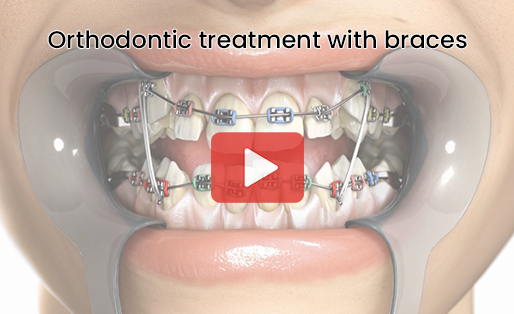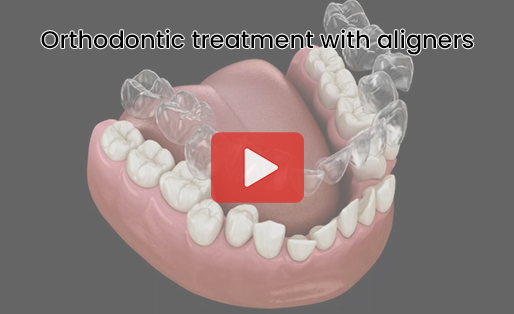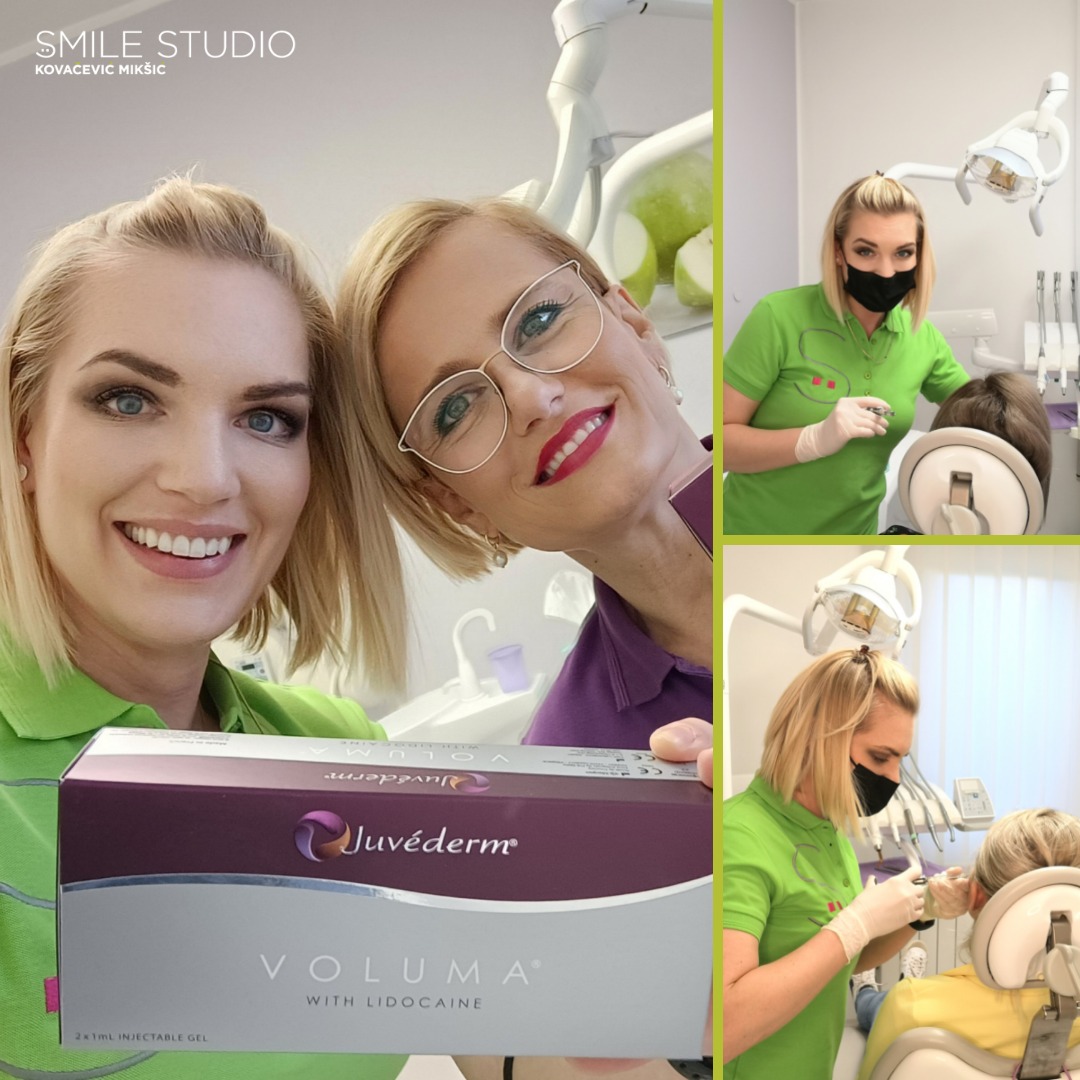DO YOU HAVE CROOKED TEETH?
CORRECT THEM! REGARDLESS OF YOUR AGE.
ORTHODONTICS
Today, correcting any dental or jaw irregularities is something that can be done in any age, so everyone can have beautiful and even teeth – recently there is an increase in orthodontic patients over 50 years of age! Orthodontic therapy doesn’t only solve esthetical but also functional and health issues like increased dental attrition or jaw muscle and joint pain.
Visit Smile Studio, require an orthodontic diagnosis and find out which possible therapies are available for you or your child.

Orthodontist, Rijeka: Orthodontic treatment with braces

Orthodontist, Rijeka: Orthodontic treatment with aligners
ORTHODONTIC THERAPY
1. FIRST APPOINTMENT
During your first appointment at the Smile Studio, our orthodontist will acquaint you with the problem and its possible solutions and alternatives.
2. SECOND APPOINTMENT
During the second appointment we will take your dental impression and after a detailed analysis of the x-ray scans and plaster models, we will suggest a detailed plan for the orthodontic therapy and compile a corresponding price offer.
3.START OF THE ORTHODONTIC THERAPY
If you accept the offer, we can start the orthodontic therapy.
DURATION OF THE THERAPY depends on the type of treated anomaly, as well as on the type of the orthodontic appliance (braces) that is used for the therapy in question. Usually we are dealing with a period of 18 +/- 6 months.
CONTROL APPOINTMENTS During the therapy it is very important to schedule regular control appointments with your orthodontist.
4. END OF THE THERAPY AND RETENTION
After the completed orthodontic therapy, the teeth have a tendency to return to their original position. This is why it is very important to wear a retainer.
What are the uses of an orthodontic therapy?
There are multiple advantages to an orthodontic therapy. By correcting inherent dental and skeletal anomalies you can restore a proper bite. Results of the therapy are visible through the esthetics of the smile and face, but they are also a requirement for the health of dental support structures, as well as the entire nervous system.
To be more precise, orthodontic therapy improves patient’s self-respect and quality of life while, at the same time, decreasing the risk of jaw muscle and joint pain, cavity, gum receding, dental attrition and wear.
How will I know what is the best solution for me?
Every individual is unique by the discernibility of their orthodontic anomaly, their musculature, skeletal and craniofacial characteristics, their age and also by their response to the orthodontic therapy. Only a detailed and comprehensive diagnosis can lead to an appropriate therapy plan and achieving the optimal individual results.
The diagnostic process starts with an appointment at the clinic, during which we estimate the extensiveness of the problem, the optimal time to start the therapy as well as patient’s preparedness and motivation when it comes to oral hygiene and regaining dental health. Based on the diagnostic results (check-up appointment, case history, plaster model, x-ray and other) it is possible to compile a detailed analysis that is used to determine an individual therapy plan.
Every aspect of the problem and the particularities of the therapy (causes and individual orthodontic anomalies, goals and suggested solutions, possible alternatives, advantages, possible risks and limits of the treatment, characteristics of the orthodontic appliance and its application as well as financial aspects of the therapy) will be discussed with the patient before starting the treatment.
Is wearing braces unpleasant?
Wearing a fixed or removable orthodontic appliance isn’t painful, but you may feel a mild pressure and discomfort for the first several days. At the beginning of the therapy, each patient is provided detailed instructions and a professional set for maintaining oral hygiene.
How often do I need to have check-ups?
Control appointments are usually scheduled ever 6-8 and sometimes even 10 weeks. Urgent situations are rare, especially if the patient follows the instructions for using and maintaining the orthodontic appliance.
How long do I have to wear fixed braces?
Duration of the fixed orthodontic therapy is individual, it depends on the problem, patient’s age and the response to the therapy, but it usually lasts for 18-24 months. The duration may depend on:
· The type of the anomaly – the more relocation the teeth require, the longer the therapy e.g. it may depend on whether the premolars have been extracted or not
· Patient’s age – therapy is usually shorter with young patients that are still growing and developing. While ageing, number of bone cells decreases along with the tissue blood flow, which makes the therapy last longer
· Regular control appointments
· Number of lost brackets – every bracket that falls out, prolongs the therapy for 4-6 weeks since the tooth starts returning to its original position and it is impossible to replace the wire with a new stronger one. In this case it is necessary to go back to the initial wire setup
How many hours a day do I need to wear the removable appliance?
The removable orthodontic appliance needs to be worn at least 14 hours a day.
Will the results of therapy be permanent?
Depending on the anomaly, the teeth can have a higher or lower tendency to return to their original position. In order to increase the stability of the achieved results we recommend wearing a retainer (special removable appliance meant for keeping the teeth in the attained position) during the night.
When is it recommended to bring a child to an orthodontic appointment?
The first orthodontic appointment is recommended at the ages of 7-8 and even earlier if you notice an orthodontic anomaly. Early therapy has numerous advantages since the anomaly is usually treated before it even fully develops and in that way you can avoid longer, more complex and expensive treatments. During the growth period it is possible to efficiently correct skeletal malformations and bite problems and in that way decrease the need for extracting permanent teeth or other surgical procedures. In addition to that, the cooperation of our little patient is usually better in this period compared to puberty. By observing the child since early years, the orthodontist can also observe the development of possible anomalies and choose the optimal time to treat them.
What if the child is already older?
When dealing with adolescents, best results are achieved through the use of fixed orthodontic appliances. During puberty it is possible to carry out lesser bite corrections. Modern diagnostic procedures and recent esthetic, self ligating systems enable a more efficient, quicker, more pleasant and more esthetically pleasing therapy.
What about the adults?
Lately orthodontics became more frequently used to solve problems in the adult stage, both in functional and esthetic correction as well as in the preparation for prosthetic, implant or surgical treatment. Patients with periodontal problems or with temporomandibular joint dysfunctions can also benefit from an orthodontic treatment.
What if I get cavity or dental tartar during therapy?
Cavity needs to be treated as soon as it is noticed. If the situation requires it, the orthodontist will remove the braces in order for the dentist to apply the necessary treatment. Dental tartar, however, can be treated without removing the braces.
It needs to be noted that the orthodontic therapy can only start when all teeth are healthy and all dental tartar has been removed.
WHAT OUR PATIENTS SAY
5 out of 5 stars
Zex Vasic
30/12/24
Una esperienza unica! Dificile a spiegare con le parole, il risultato ottenuto dopo che il Smile studio ha fatto il lavoro sulla struttura di miei denti. Dal inizio , la situazione di miei denti era poco dire disastrosa. Dopo anni di rinvio, ho deciso di rivolgermi a questo meraviglioso team di persone straordinarie ! Consigliato dai alcuni amici, e trovando tutte le informazione sul web, gli ho contattato e da lì ho iniziato un percorso che ha durato quasi un anno e mezzo. Ogni appuntamento è stato rispettato con la massima puntualità ! La signorina Nina, che si occupava di lavori amministrativi , ha saputo gestire tutto con la massima professionalità . E questo era molto importante perché ho dovuto viaggiare sempre da lontano! Gentilezza , e ambiente dove ti senti come fra amici, era al livello altissimo! Che mi aiutato molto di resistere e continuare fino alla fine. La loro onestà si è vista sul alcune situazioni dove alcuni lavori non sono stati fatti o non più dovuti, se anche preventivati,indicati e ridotti dal prezzo finale. Risultato di tutto ciò è il mio splendido sorriso che dopo tanti anni posso di nuovo dimostrare a tutti. Sono poche le 5 stelle che li posso dare! Consiglierei a tutti Smile studio! Approfitto ancora una volta di ringraziare a tutto team dello studio per loro impegno e la dedicazione nel loro lavoro! Un abbraccio a tutti!
Pročitaj višemanje
5 out of 5 stars
sandra janeš
20/11/24
Sretna sam što sam za izradu ALL ON 6 implantanta, obostrano podizanja sinusa i još nekih dodatnih zahvata izabrala Smile studio-Rijeka. Moj strah vezan za takve zahvate bio je velik. Danas sam presretna sa novim lijepim osmjehom i zdravom čeljusti. Dr. Tamara i Dr. Damir stručno i smireno vodili su me do kraja postupka. Divne djevojke Sara i Nina odmah po dolasku osvajaju osmjehom i tu svaki strah nestaje. Njima kao i ostaloj ekipi u Smile Studiju sve pohvale i iskrene preporuke. Dodajem dodatne zvjezdice jer ih zaslužuju. ✨✨✨✨✨
Pročitaj višemanje
5 out of 5 stars
Edmond Brajkovic
20/11/24
Htio bi iskreno zahvaliti cijeloj ekipi iz Studija Smile! Naime, već dugi niz godina imam problem s hrkanjem i apneom koje nikako nisam mogao riješiti. Napokon sam se pokrenuo i odlučio napraviti Silensor udlagu i odabrao Studio Smile. Cijela je procedura od pregleda do izrade prošla jednostavno i brzo (2-3 dana), a udlaga je napravljena vrlo kvalitetno. Dobio sam i precizne upute za upotrebu i održavanje. Na kraju bi izdvojio i vrlo konkurentnu cijenu, što nije mala stvar kad je u pitanju Silensor udlaga. Benefiti upotrebe udlage vide se odmah: puno manje hrkanja, više kisika, bolji san, lakše ustajanje, puno manji umor tokom dana. Još jednom sve preporuke i veliko hvala cijelom timu!!
Pročitaj višemanje
5 out of 5 stars
Kelly DeJardin
10/11/24
After a lot of research, I decided to book an appointment to have major dental work done at Smile Studio. I am normally very fearful of the dentist, but everyone at this office made me feel very comfortable. The receptionist, the hygienist, the dentist, and even the lab workers were all so kind and professional. The office is extremely clean and high-tech. Everything appears brand new. They do incredible work. I had two crowns, and you would never know that the teeth were not my own. The lab hand-painted my crowns to match my unique coloring. I am so impressed, and I will make this my regular dentist, even though it means that I need to take a flight to get there.
Pročitaj višemanje
5 out of 5 stars
Sime Dedic
20/10/24
Kod ugradnje implantata u donju vilicu želim se zahvaliti gospodinu Dr. Damiru na pažnji i stručnoj izvedbi, jer prvi puta u životu nisam kod zubara osjećao nikakve bolove za vrijeme rada niti nakon toga, iako sam se malo bojao, jer je trebalo bušiti kost donje vilica za ugradnju nosača implantata! Sve pohvale i zahvalnost Dr. Damiru na stručnoj izvedbi i maksimalnoj pažnji.
Pročitaj višemanje
5 out of 5 stars
Vesna Žigić
20/08/24
Pred mjesec dana sam napravila Silentor i stvarno djeluje ODMAH. Prilikom prvih par stavljanja bila sam malo nespretna a sad ga stavim u sekundi i vrlo brzo zaboravim da ga imam. Spavanje bez njega je nezamislivo i meni i mužu. Preporučam ga svima koji hrču jer podiže kvalitu sna vama i svima oko vas. Vesna Žigić
Pročitaj višemanje
5 out of 5 stars
Gordana Dželalija
20/08/24
Aparat/proteza protiv hrkanja uspješna 100%. Osoblje vrlo ljubazno, doktor je fantastično opisao problem i rješenje tako da odmah shvatite da bi to trebalo funkcionirati. Sve se vrlo brzo rješava osiguravajući miran san sebi i ukućanima. Preporuka: nemojte kupovati razne gluposti s interneta koje sprečavaju hrkanje jer ne sprječavaju! Investirajte u Silensor protezu i zaboravite na hrkanje i apneju :-).
Pročitaj višemanje
5 out of 5 stars
Ivana Radočaj
20/07/24
Prvo dogovor je bio brz i narucili su me tocno kada sam mogla. Drugo jako se bojim ici stomatologu, no danas je taj strah nestao. Radila sam dugotrajni proces lijecenja kanala koji je rijesen u jednom danu i doslovno 99% nisam ni osjetila. Doktorica se stvarno potrudila i oko mog zuba i oko mog straha. Nevjerovatno olakasanje za mene i veliko povjerenje u zdraviju buducnosti mojih zuba sada kada kmam zubara kojem vjerujem.
Pročitaj višemanje
5 out of 5 stars
kushii ta
15/07/24
I had a great experience at the dental studio. I’ve always been afraid of dentists due to past unpleasant experiences, but this visit was different. The team was incredibly friendly and made sure I felt comfortable from the moment I walked in. Throughout the procedure, they frequently checked in to see if I was okay, which really helped. I highly recommend them for anyone with dental fears—they truly know how to make their patients feel at ease and provide top notch treatment.
Pročitaj višemanje
5 out of 5 stars
Luca Stabile
17/06/24
Samo POHVALE, jako su ljubazni i pazljivi, kako preko telefona tako i uzivo. Temeljito i razumno objasne apsolutno sve sto vas zanima. SILENSOR protiv hrkanja je opravdao sva njihova obecanja, stvarno funkcionira 100%. Ako nekog zanima moje osobno iskustvo u vezi SILENSORA protiv hrkanja, slobodno zatrazite moj kontakt.
Pročitaj višemanje
5 out of 5 stars
danilo spazzapan
01/06/24
Volevo provare il Silensor per russamento abituale prolungato e qualche volta 2-3 episodi di apnea. Il portale di Smile è molto ben impostato, ci sono anche le prestazioni con i prezzi chiari. Ho avuto immediata risposta in E mail alla richiesta di informazioni. Sono riusciti a organizzare la presa delle impronte al mattino con consegna del Silensor nel primo pomeriggio. Tutto molto bene: bello studio, accoglienza gentilissima, visita preliminare e impronte fatte in maniera molto accurata e professionale. Arrivato l’apparecchio, sono state fatte alcune piccole limature per una perfetta personalizzazione e fatta la prova di autonomia metti e togli. Programmato un contatto di controllo dopo una settimana per eventuali problemi. Lo uso da più di un mese, la prima settimana per 15-30 minuti qualche doloretto ai muscoli al mattino, poi più nessun disturbo. Nel mio caso il russamento è significativamente diminuito per sonorità e durata, non sono più stati registrati episodi di apnea. Eccellente esterienza!
Pročitaj višemanje
5 out of 5 stars
Tea Horvat
01/06/24
Jedno jako ugodno i pozitivno iskustvo sa svim zaposlenima s kojima sam imala prilike se susresti. Prvenstveno je naglašena profesionalnost i ljubaznost te fokus na individualnom pacijentu, što definitivno smanjuje anksioznost i brigu, pogotovo kod ljudi sa prethodno lošim iskustvom. Sve u svemu, jedno jako ugodno iskustvo koje mi je popravilo pogled na odlazak zubaru! 10/10
Pročitaj višemanje
5.0
217 recenzija
5
214
4
0
3
0
2
1
1
2



